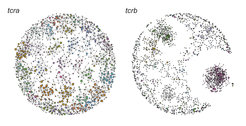Comparative analyses of TCR repertoires in vertebrates
Lab Boehm

The definition of the minimum size of the TCR repertoire that is required for sufficient cellular immune defense remains a major unsolved question in cellular immunology. Using an information theoretical approach to characterize TCR repertoires, we are studying this question using animals exhibiting vastly different body mass.
To this end, we have studied TCR diversity of the cyprinid minifish (Paedocypris spp.), which represents the smallest adult vertebrate known to date. We have characterized the four TCR loci, determining the number of their V, D, J and C elements. When viewed on a general level, these loci exhibit all hallmarks of a vertebrate TCR complement, although the numbers of individual elements encoding the variable part of the receptors appears to be smaller than those in the zebrafish. We determined the sequence diversities of minifish CDR3 regions of all four TCRs, determined the structure of the repertoires (Fig. 1), and uncovered unprecedented changes in the genes encoding components of the CD3 complex, pointing to a new regulatory mode affecting TCR signaling, potentially related to the reconfigured network of adaptive immunity based on reduced overall TCR diversity in minifish.
We are now following up these observations in order to establish commonalities and differences in the repertoire architectures of small and large vertebrates.
